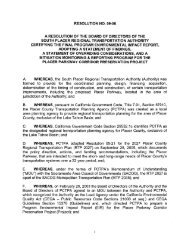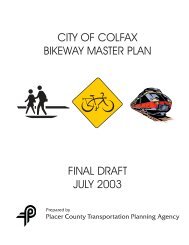Bus Rapid Transit (BRT) Implementation Study for South ... - pctpa
Bus Rapid Transit (BRT) Implementation Study for South ... - pctpa
Bus Rapid Transit (BRT) Implementation Study for South ... - pctpa
You also want an ePaper? Increase the reach of your titles
YUMPU automatically turns print PDFs into web optimized ePapers that Google loves.
<strong>Bus</strong> <strong>Rapid</strong> <strong>Transit</strong> (<strong>BRT</strong>) <strong>Implementation</strong> <strong>Study</strong> <strong>for</strong> south Placer CountySeptember 8, 20064.4 <strong>BRT</strong> STATION LAND USE EVALUATIONThe following evaluation was initially prepared <strong>for</strong> the Conceptual <strong>BRT</strong> Plan <strong>for</strong> south Placer County (April 11,2005), prepared by Fehr & Peers <strong>for</strong> the Placer County Department of Public Works. The station land useevaluation has been updated to reflect new land use data included in the Super Cumulative travel demandmodel.As the first step of identifying the potential <strong>BRT</strong> station, future land uses (i.e., population plus employment)were evaluated within the study area. Based on the station evaluation criteria described above and the landuse <strong>for</strong>ecasts, the south Placer area was divided into ½-mile grids using GIS analysis tools and ratedaccording to potential station development levels to identify the best candidate sites <strong>for</strong> future <strong>BRT</strong> stationsbased on current development plans. As shown in Figure 6, 15 initial station locations were identified throughthis review. Figure 6 shows the station location, station development level, and analogue ridershipin<strong>for</strong>mation <strong>for</strong> each station development level.The station development levels measure land use intensity in relation to increasing levels of potentialridership based on empirical data. Fehr & Peers determined a range of potential transit ridership <strong>for</strong> eachdevelopment level by identifying actual year 2000 ridership at existing analogous rail stations in Sacramentoand San Francisco Bay Area regions. These analogue stations are from a database developed by Fehr &Peers on over 80 rail station sites in northern Cali<strong>for</strong>nia. This database includes station ridership as well asstation area data on population and employment, transit service levels and other characteristics. Specifically,this database covers 40 BART stations, 33 Caltrain stations, and 11 non-downtown Sacramento LRT stations.Analogue stations <strong>for</strong> the potential <strong>BRT</strong> stations in south Placer County were identified primarily on the basisof station area population and employment (focusing on the area within one-half mile of the potential stationsite). An attempt was made to identify a “lower ridership” and “higher ridership” analogue station from boththe Sacramento and Bay Area region. Thus up to four existing analogue stations were identified <strong>for</strong> eachpotential <strong>BRT</strong> station in south Placer County.The station development level and analogue ridership in<strong>for</strong>mation on Figure 6 can be used to gauge thepotential ridership of identified station locations based on current land use plans and to compare the individualstation locations against each other. As shown, there is no ridership data <strong>for</strong> the low end of Level 1 and highend of Levels 5 and 6 because the analogue stations in Sacramento are not available.Figure 6 shows that the Placer Ranch Specific Plan area and the Galleria Mall area are two candidate <strong>BRT</strong>station sites with high ridership potential. To supplement the land use projections described above, additionaltravel in<strong>for</strong>mation was developed to assist in identifying potential <strong>BRT</strong> travel markets and corridors. Theprojected origins and destinations of travelers from the Placer Ranch and Galleria Mall areas weredetermined using the Super Cumulative Model. Table 3 shows the projected number of total daily persontrips, as aggregated into home-based-work (HBW) trips and non-home-based-work (Non-HBW) trips.22





